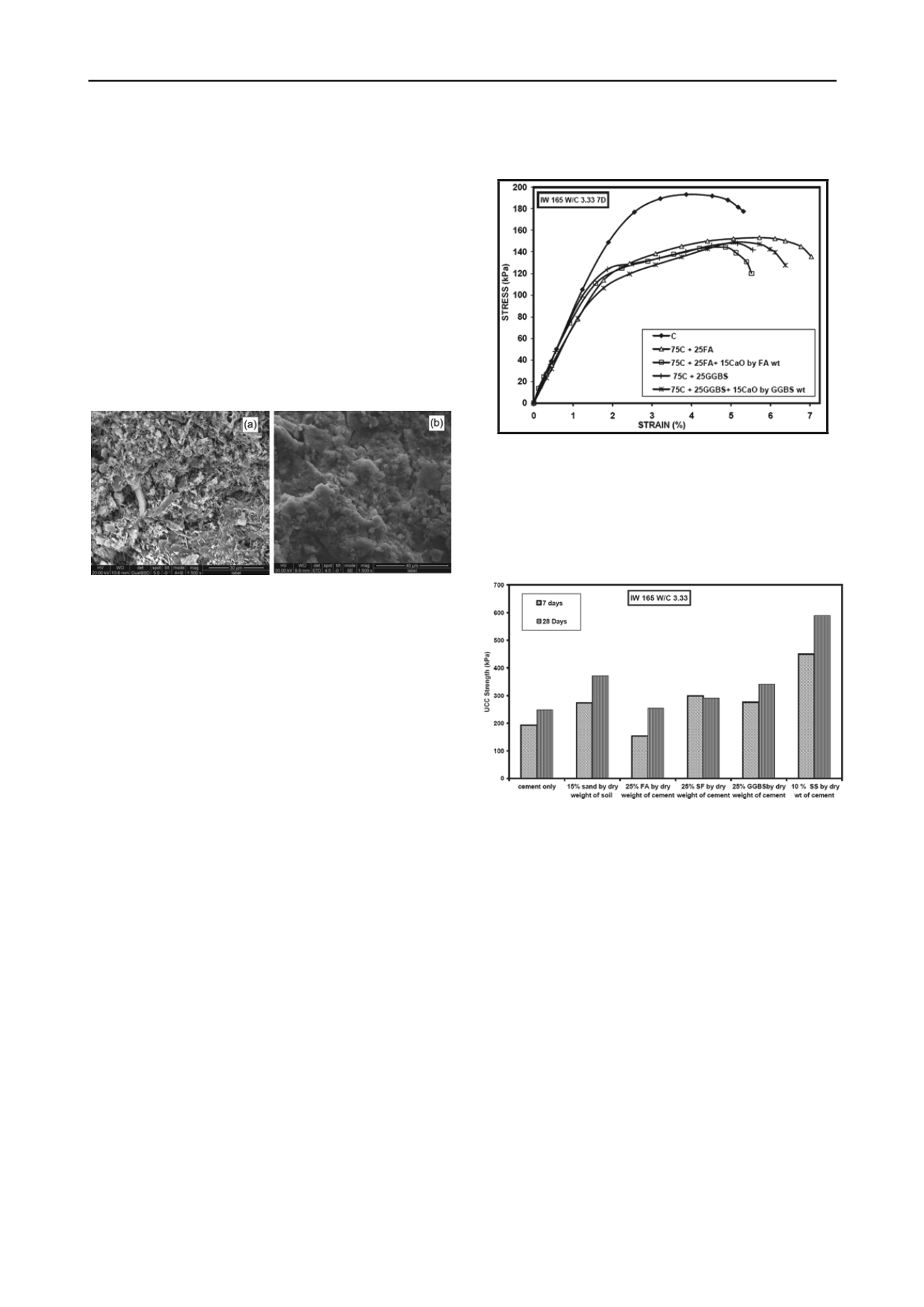
431
Technical Committee 101 - Session II /
Comité technique 101 - Session II
Proceedings of the 18
th
International Conference on Soil Mechanics and Geotechnical Engineering, Paris 2013
ratio it can be concluded that the cementation compounds are
still insufficient to bind the clay fabric in case of high W/C ratio
whereas at the lowest W/C ratio the cement matrix is
continuous binding the clay aggregates contributing to a
significant strength gain.
It can be seen from Figure 3 that the effect of curing is
almost negligible and this is mainly because the organics
tending to coat the surface of the soil particles impeding the
interaction between clay minerals and the cement hydration
products harming the long term strength gain contributed by
secondary reactions (Chen & Wang 2006). Results indicate that
for the same W/C ratio the variation in initial water content has
very little influence on the long term strength gain thus
confirming the critical role played by W/C ratio in strength
development of cemented clays as suggested by Miura et al.
(2001).
Figure 4. Fabric of Cemented Kuttanad clay (a) W/C 6.5 (b) W/C 3.33
3.2 Cement Composite binder combination
With an effort to economize and reduce the carbon foot print of
the proposed ground improvement technique, composite binder
combinations such as cement – Lime, Cement – FA and Cement
– GGBS were tried.
3.2.1 Cement-Lime
Quick lime as reported in literature (Åhnberg and Johansson
2005) as a possible replacement for cement was tried in
different proportion with cement and the UCC tests were done
on stabilized soil samples. For IW 165 % and W/C ratio 5,
Cement(C) - Quick Lime (L) binder combinations of 75C-25L
and 50C-50L were tried and the UCC strength at the end of 14
days curing was found. UCC strength of the sample with only
cement as binder was 99 kPa where as with lime replacement
the strengths significantly reduced to 33 kPa (75C-25L) and 25
kPa (50C-50L). Development of strength happens when the
added lime reacts with the clay minerals. As soon as lime is
added, pH increases and there is De-flocculation of soil fabric
and removal of organics adsorbed on to the minerals. The
organic matter hinders the reactions between added lime and the
clay minerals present in the soil hence there is no beneficial
effect of lime replacement observed. Diatom silica is also found
not reacting with the added lime confirming the role of
components such as organic content and sesquioxides (Van
Capellen et al. 2001) present in the soil inhibiting its solubility,
finally retarding the puzzolonic reactions responsible for
strength development.
3.2.2 Cement - Mineral admixtures
Figure 5, shows the stress – strain characteristics of cement with
GGBS and Fly ash binder combination with and with out lime.
It can be clearly seen that the effect of replacing a portion of
cement with either of the mineral admixtures (GGBS / FA)
results in strength loss when compared to the cement alone case.
Hence it reinforces the fact that the positive effect of puzzolonic
reactions is not enough to offset the role of cement which is
replaced. Both lime released and lime added have insignificant
role to play in enhancing the strength of the Cement - Mineral
admixture stabilized Kuttanad soil.
Figure 5. Stress Vs Strain for cement- mineral admixture combination
3.3 Role of Admixtures
To further enhance the strength of soil with cement as binder
different additives with varying reactive silica content were
considered. Results from UCC tests of different additives such
as Fine sand, Fly ash, Silica fume, GGBS and Sodium silicate
used along with cement are shown in Figure 6.
Figure 6. Effect of various additives on UCC strength of cemented soil
It is evident from Figure 6, that addition of fine sand to the
mix has enhanced the shear strength of the cement stabilized
soil. The mechanism of strength enhancement in this case can
be attributed to the matrix of cemented sand supporting the
weak soil within it. It is well known that the cement can bind
very effectively the coarser sand particles involving lesser
contact points than the fine organic soil.
The addition of fly ash resulting in no strength improvement
can also be due to the interaction of the strengthening matrix of
both soil cement and fly ash cement system leading to a weaker
framework.
Silica fume as an additive with cement resulted in 17 %
strength increment in case of 28 days cured samples (Figure 7).
The strength increment is marginal and can be attributed to the
participation of silica fume in the pozzolanic reactions,
involving lime liberated from cement hydrolysis.
Adding 25 % GGBS by weight of cement resulted in a
strength increase of about 37 % at the end of 28 days curing
(Figure 7). The strength increase is due to the formation of
cementation products because of the alkali activation of GGBS
caused by cement hydrolysis (Taylor 1997). GGBS is coarser
and accommodates soil in its matrix and the subsequent
production of cementitious products by itself results in effective
binding giving an enhanced strength.


